The WSA is happy to welcome Nancy Boyle back as an exhibiting member. She is a dedicated plein air oil painter, inspired by the New England landscape. To see more of her paintings, visit her WSA artist page.
Welcome back Nancy!
The WSA is happy to welcome Nancy Boyle back as an exhibiting member. She is a dedicated plein air oil painter, inspired by the New England landscape. To see more of her paintings, visit her WSA artist page.
Welcome back Nancy!
September Artist of the Month
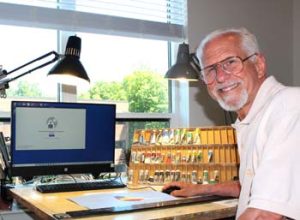
Meet Nelson Hammer
Growing up on Long Island in the 1950s, one of the few elementary school-related assignments I remember was given to us at end of each school year: We had to draw a picture of a child running after a truck. The results were kept by the schools (no copiers then!) to measure the artistic progress of each student over the years. My teachers and friends always thought highly of my efforts, and it was one of my favorite assignments to do. I’ve enjoyed drawing for as long as I can remember, and still own many sketches I did as a teenager.
My parents bought me an oil-painting set when I was in college, and I took to it with relish. I also supplemented my parents’ allowance at school by doing charcoal portraits of my friends, with my best friend standing behind me to give me real-time critiques of my progress because I had a tendency to err on shapes and forms. I charged $2 a pop. Not much of a supplement.
I graduated with a BS in landscape architecture in 1969. Upon graduation, getting job, earning a living, getting married and having a family became roadblocks to my work in oils, especially because I painted so slowly. Despite my interest, I never took art classes during or after college. After my two children left home for school, I created a few more oils, but was becoming less interested in it due to the odors of turpentine and linseed oil…and the lack of ventilation.
During the summer of 2014, as I was strolling through a Michael’s crafts store with my wife and two eldest granddaughters, I spotted a starter watercolor kit and bought it on a whim. Now, what to paint? I digitally strolled through the web, keyed in beautiful, colored birds, and off I went. I had painted several birds when a friend advised me that I could liable for copyright infringement by creating derivative images of published material. I thought my bird painting was over!
Enter two relatives who were excellent amateur photographers: my daughter’s mother-in-law, Brenda Robert, and a first cousin, Mike Funk. They were eager to offer me an endless supply of subject matter, and a year or so after that, I received permission from several professional bird photographers to use their photos without fee. Crisis averted….until I filled out applications to join the Wellesley Society of Artists (WSA), and later, the New England Watercolor Society (NEWS). Both forbid the use of photos by others as source material. Gotta use my own photos!
Since bird photography is an art form of its own of which I had neither the skill nor the desire to learn, I turned to landscapes several years ago, which my landscape architectural background had helped foster. When my wife passed away in 2021 after living in Needham for 42 years, I moved in 2022 to an apartment in Wellesley Hills located across Route 9 from the Hemlock Gorge Reservation, home of Echo Bridge. If it is possible to fall in love with an inanimate object, I did just that, and have painted the bridge four times and counting.
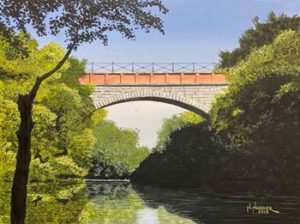
However, the allure of painting birds and other fauna remained, yet I was resolute in wanting no part of investing in telephoto lenses and learning the nuances of DSLR and/or smartphone cameras. What to do? I know! Go to where birds and other fauna- having no fear of humans- casually interact with us without the need for a long lens! Off I went last December to the Galapagos Islands, had the time of my life, and took dozens of photographs of birds, sea lions, lizards, and giant turtles that have already been- and will in the future become additional- source material for my watercolors.
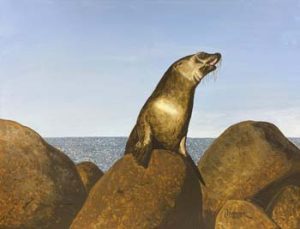
I was quick to realize that joining local associations would be very helpful me in both displaying my art and networking with other artists; I joined the Needham Art Association the same year I started painting. Since I was still as yet unable to wean myself from using others as photographic sources, I did not join NEWS until 2018 and was made a Signature Member in 2022. I also finally joined WSA soon after I moved to Wellesley Hills.
My painting style- realism with a focus on detail- dictates that I paint deliberately. I make no effort to hasten the completion of my pieces for a few reasons:
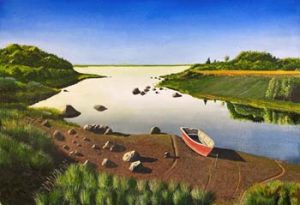
Lastly but most importantly, art has been by my side and in my head when I needed it most during the past few years. Since I started painting in watercolors in 2014, orthopedic issues have taken tennis, then golf from me. But I can still paint! In the last three years, I lost my wife of 49 years, sold my house, moved to an apartment in another town, and retired the day I moved. A lotta stuff to absorb, and I couldn’t have gotten through it as readily as I did without my art… a blessing NOT in disguise!
The WSA is happy to welcome new exhibiting member Pilar Figueira. Her captivating paintings while nostalgic have a pleasingly modern twist, intended to explore the theme of memory. To see more of Pilar’s paintings visit her WSA artist page.
Welcome to the WSA Pilar!
August Artist of the Month
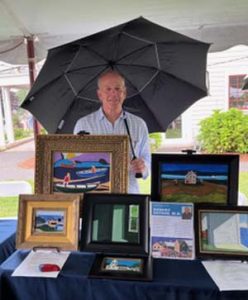
Meet Robert Savage
Dr. Savage is a retired surgeon, assistant clinical professor at Harvard Medical School and Past President of the New England Society of Plastic & Reconstructive Surgeons. He is a life-long art lover and started a second career in 2016 as a local art historian, collector and now artist. He is eternally grateful to WSA for all the support and friendship he has received in these new art adventures. He is particularly proud to have been involved in 2023 writing of a 36-page booklet on the amazing 90 Year History of the WSA and celebrating its anniversary with a lecture on the topic at the Wellesley Free Library in conjunction with the Wellesley Historical Society.
Basically self-taught Bob is inspired by the Cape Cod folk art tradition of the Cahoons and Elizabeth Mumford, and the soulful Provincetown and Truro paintings of Anne Packard and Edward Hopper. His work concentrates on iconic scenes of New England, especially the Cape and Islands. During his process he enjoys using different geometric shapes and color experimentation. His latest project is transforming classic, early works by the Provincetown Printers into what he refers to as “white line” acrylics.
He formerly curated two art blogs on Facebook: the Wellesley Collection Art Review and Friends of the Rockport Art Association and Museum. He has published over one hundred brief biographies on AskArt.com and consulted for the Massachusetts Horticultural Society on art acquisitions.
His personal collection has been featured in the American Fine Art Magazine, and he is a frequent art history contributor to the Wellesley-Weston Magazine, where his career transition from physician to artist was featured in the 2022 summer edition. He is an exhibiting member and was a board member of the Wellesley Society of Artists. His current writings and lectures focus on women artists of the early twentieth century.
Exhibitions:
Rockport Art Association Museum
Annual Grassroots: Emerging Artists Exhibition, July 2021, July 2022, August 2023, June 2024
Contributing Members Exhibition 2022
Osterville Village Library, Osterville, MA, Cape Cod
3rd Annual Plein Air Exhibit, July 2021
4th Plein Air Exhibit July 2022
5th Plein Air Exhibit, July 15,2023,6th Annual Exhibit July 20,2024
Contact:-wellesleycollection@yahoo.com
The WSA is happy to announce that rising WHS seniors Katie Gallico and Evelyn Harrison were awarded the Annual Art Achievement Award in early June. In addition to the award Katie and Evelyn will be participating in the WSA’s Annual Library Show in November.
In 2017, the WSA reinstituted the Annual Art Achievement Award, which is a cash prize that is given to a Wellesley High School student who demonstrates both merit and dedication to their art studies.
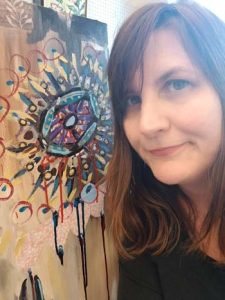
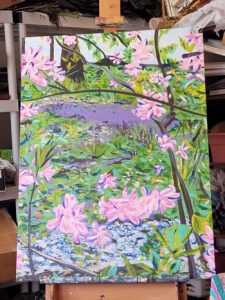 Cathy is currently working on a 30” X 40” painting inspired by a spring walk at Garden in the Woods, Framingham. There were many vibrant layers of beautiful colors on that particular day. This painting will become part of a show called “Views of Framingham” that is supported by a grant from the Framingham Cultural Council through the Mass. Cultural Council. The eight painters at Howard Street Studios, most of whom are WSA members, are taking part in this rotating venue exhibit from late summer into the winter. Proceeds from sales of their art will support community based nonprofits.
Cathy is currently working on a 30” X 40” painting inspired by a spring walk at Garden in the Woods, Framingham. There were many vibrant layers of beautiful colors on that particular day. This painting will become part of a show called “Views of Framingham” that is supported by a grant from the Framingham Cultural Council through the Mass. Cultural Council. The eight painters at Howard Street Studios, most of whom are WSA members, are taking part in this rotating venue exhibit from late summer into the winter. Proceeds from sales of their art will support community based nonprofits. June Artist of the Month
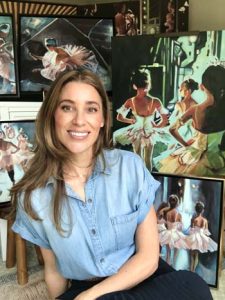
Meet Cora Ainge
When did you start painting and what do you love about it?
It wasn’t until my early 30s that I first picked up a paint brush. In an attempt to survive being cooped up with young kids during a particularly harsh Boston winter, I grabbed some cheap paint, brushes and canvases at a craft store one afternoon. As I sat with my boys at the kitchen table painting, I was surprised by how relaxed I felt and how quickly the time had passed. I remember putting my kids to bed that evening and rushing back to the kitchen to paint again. I loved it and painted hours into the night without realizing it.
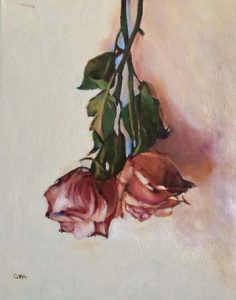 My dad had tragically died 3 months prior in a car accident at the age of 58. Still very much buried in grief, I found myself turning to the little painting station I’d set up in the kitchen. Each evening after my kids were in bed, I’d quietly paint and began to realize it was giving me a much needed break from the sadness of losing my dad so suddenly. The process of painting had a way of sucking me into a state of flow that was incredibly healing.
My dad had tragically died 3 months prior in a car accident at the age of 58. Still very much buried in grief, I found myself turning to the little painting station I’d set up in the kitchen. Each evening after my kids were in bed, I’d quietly paint and began to realize it was giving me a much needed break from the sadness of losing my dad so suddenly. The process of painting had a way of sucking me into a state of flow that was incredibly healing.
As time went on, my love for painting grew strong. I was so thankful for YouTube because I felt like I could learn how to paint just about anything – all I needed was my iPad, painting supplies and a cup of tea. I did every demo I could find!
It wasn’t long before I was deeply in love with painting and I remember how the world around me had turned into a palette of paint. I couldn’t help but look at trees and sky without color mixing in my mind. I began to appreciate color (and the world around me) in a whole new way – there were suddenly so many fun little color puzzles around me, all the time!
The joy of color theory was one thing, but what I was completely mesmerized by, was light. Like a moth to a flame, I obsessed over the powerful effect light had on what I was painting. Playing with light is how I learned to infuse my paintings with mood and atmosphere. Not to get too annoyingly “artsy” here, but once I figured out how to paint light, I started to actually feel, dare I say a bit of “emotion”, when I looked at my paintings (ew gross, sorry). But, it’s true! Sometimes the most simple wisp of light can take a painting from stale to serene and that’s what draws us in!
After some time, and through much trial and error, I began to churn out original paintings. I’d hang paintings on my walls and soon I was painting for friends and family. Like most artists starting out, I remember being absolutely floored when complete strangers were willing to give me real money in exchange for my art. What?! I don’t think the shock of that will ever wear off. After some encouragement from loved ones, my little LLC was born and I couldn’t be happier.
What do you like to paint and what are you currently working on?
I paint a lot of flowers and landscapes (golf courses, in particular), but what I’ve really been loving to paint lately are ballerinas. I had a solo show of ballerina paintings last year and I loved painting them so much I’ve started working on a second series.
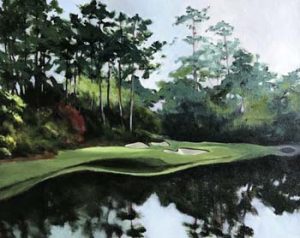
Strangely enough, however, some of my most enthusiastic buyers are golfers. I saw there was a hole in the golf painting market when I noticed how giddy my golf-obsessed husband and his buddies would become when chatting about their golf outings. But what I didn’t expect was that most of my golf paintings would actually be purchased by women who came to know my work because they saw my flowers or ballerinas – turns out a lot of them are also married to golf nuts and golf paintings make great gifts. Works for me!
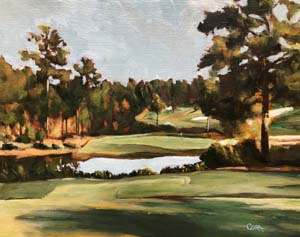
Follow Cora on Instagram @coraaingeart
The WSA is happy to welcome new exhibiting member Sheila Davis. She is a representational painter inspired by the New England coast. Her paintings capture the atmosphere and light that make these areas so inspiring for artists. Not only does Sheila paint herself, she has enjoyed a long career teaching art. To see more of her artwork visit her WSA artist page. Welcome to the WSA Sheila!
May Artist of the Month
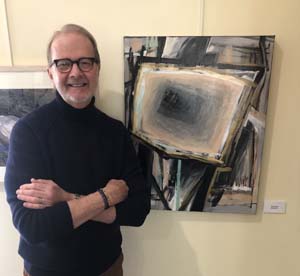
Meet Michael Murphy
Michael Murphy has had multiple chances to expand his universe in his 71 years and continues on his 53-year-old artistic journey to this point in his life. He grew up in Texas and after high school, he attended art school at Texas Tech University, studying painting, drawing, and printmaking. Life took him in a different direction after his graduation, however, and Michael pursued a career in education, believing he was being pointed toward a world of teaching and working with students. After a successful career as a teacher, assistant principal, principal, director, assistant superintendent and superintendent, Michael turned to working with schools across North and South America as a national leadership coach, trainer, planning facilitator, and consultant. He has been fortunate to have continued his consulting work for 15 years.
In spite of his important work with school leaders, Michael never lost his love of design and art in architecture, nature, and abstraction. So, after a move to the Boston area and with the support of his family, he was able to rearrange his life, retire, and expand his personal world to involve the production of paintings, drawings, and prints to showcase his emotions and thoughts. He was also fortunate to have found the Wellesley Society of Artists as an important part of his work, and he currently is the vice-president of the WSA. Michael’s exploration takes him to expressive abstraction as he studies design, form, shape, mood, motion, and color.
Michael explains: “My images come to me softly and often with just a whisper—there is beauty in the moment when you have inspiration and clarity for the work. That whisper, the softness, may become a roar with time on the canvas. Whatever the canvas transition becomes, I want my works to project a sense of surprise, wonder, movement, and love for the new, unknown, or unspoken. It may take me to project an uplifting moment or a moment of despair. I let the immediacy the paint on canvas to take me where it wants to go.”
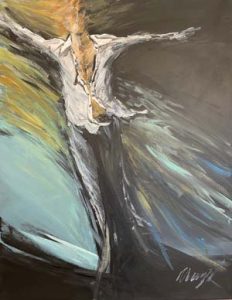
Michael welcomes your contact and can be reached at michaelmurphy@murphysoftmodernart.com
Artist of the Month
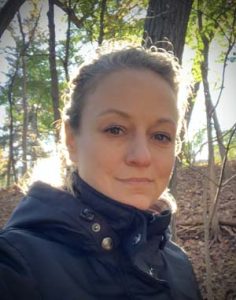
Meet Chelsea Sebastian
Chelsea Sebastian is a representational oil painter who creates reflections of her daily life from her studio in Wellesley, MA. She works from sketches, photographs, and memory, often combining images to compose poignant paintings of vernacular places. She derives inspiration from her childhood on a small farm, extensive world travel, and New England’s dramatic seasons and dynamic community. Her artwork is held in collections throughout the United States and Canada. Recently, she was chosen to be part of the U.S. State Department’s ‘Art in Embassies’ program.
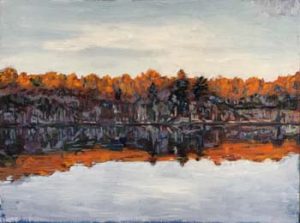
WHAT IS YOUR BACKGROUND?
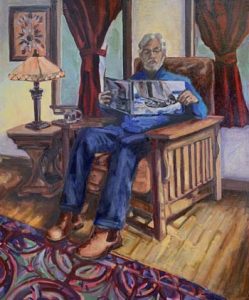
Because I was raised in a large family by two painters, I have been making art since childhood. My dad is a maritime watercolorist and my mom is a portrait artist who works in acrylics. I hold a degree from the University of Washington in Community and Environmental Planning and a Masters of International Studies from North Carolina State University. Invariably, I paint at every opportunity, and relentlessly examine art history and human creativity. Since 2021, I have been studying figure painting from life at the Academy of Realist Art in Boston
WHAT IS YOUR PROCESS?
I call my process “Assemblage and Archeology.”
Assemblage: Through sketching, photography and deep observation, I collect images of people and places. In my studio, I engage in an awkward analog process of combining images. I print, copy, trace, cut-out, collage, sketch, and re-draw compositions. I often carry around an assemblage for years and study it whenever I have a moment of pause.
Archeology: I build my paintings by applying direct impasto layers of color over numerous painting sessions. As a painting takes form, I scrape off texture between sessions. I tremendously enjoy this tiny act of destruction. I rediscover paint layers and remind myself that my previous work is not yet precious. I put in earplugs and get physically close to the canvas, scraping with a pallet knife and wiping with my hand. During this process, I enter a soft consciousness where I only think about mixing color and creating form.
WHAT DO YOU PAINT? AND WHY?
My current work is a reflection of my daily life. I am in a personal era of suburban domesticity and my art reflects home, children, pets, and my beloved neighborhood. With fidelity, I attempt to capture subjective experiences and accurately portray how New England’s stark light magnifies minor places in the landscape and plays on architecture. My work is also a reflection of my psychological state, as I am sensitive to my family’s growth and how our community engages with nature. More than anything, my paintings chronicle my joy and connection with this time and place. They are both composites of isolated moments and are my effort to keep record of the fundamental importance of my life.
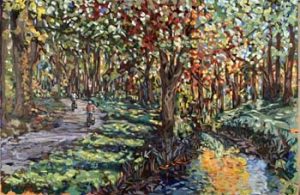
WHAT ARE YOU WORKING ON NEXT?
I set myself the task of mastering portraiture over the next two years. I have started with my immediate family members and am enrolling my neighbors and friends as models. I continue to study at the Academy, show locally, and spend as much time as possible alone in my basement, beside the boiler, painting.
